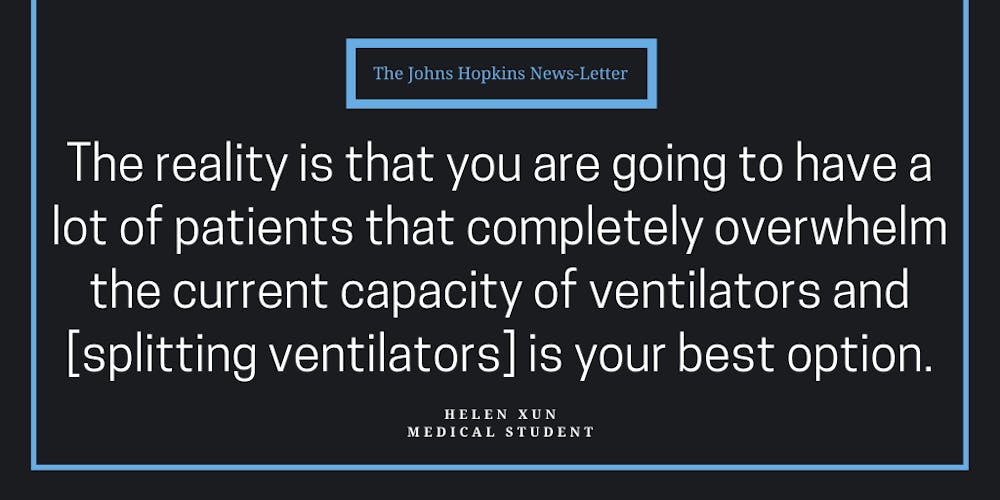A team at Hopkins is working to develop a ventilator splitter that will allow hospitals to maximize the utility of their existing ventilators. As the number of cases of coronavirus (COVID-19) rapidly increases, hospitals across the nation are struggling to manage the influx of patients with insufficient supplies.
Dr. Julie Caffrey is an assistant professor of plastic and reconstructive surgery at Hopkins who trained in New York with physicians who are now fighting in the nation’s COVID-19 epicenter. In an interview with The News-Letter, she discussed what sparked her idea to create a ventilator splitter.
“I have a lot of friends in New York who are trauma critical care surgeons. They are fighting an uphill battle right now in regards to COVID-19,” Caffrey said. “They felt like they didn’t have enough ventilators for the number of patients that are getting sick.”
After hearing these concerns, Caffrey came up with a solution that could potentially help health-care institutions that are quickly being overwhelmed with patients due to the lack of sufficient supplies, such as ventilators.
“I had an idea that if we could split ventilators in a safe manner, maybe that would be a good fix,” Caffrey said.
Caffrey was put in touch with Helen Xun, a medical student at Hopkins who had been working on a project studying the ability of 3D printing technology to rapidly prototype medical devices. Xun reached out to Sung Hoon Kang, an associate researcher for the Institute for NanoBioTechnology, and Christopher Shallal, a junior Biomedical Engineering student, to form a team that could work on Caffrey’s idea.
Xun discussed how the team was able to quickly begin work on the ventilator splitter.
“For the last few months, we have had a translational interdisciplinary research team of clinicians and engineers who have been working together, which founded a good basis for Dr. Caffrey to jump in with her idea,” Xun said in an interview with The News-Letter.
The idea of splitting ventilators is not new, as hospitals across the nation are scrambling for them. However, physicians are reluctant to split ventilators between patients. Each patient presents a unique situation and thus requires a unique treatment. Placing multiple patients on a single ventilator means that the treatment can no longer be tailored to both patients, which could be detrimental.
Although physicians recognize that splitting a ventilator is not ideal, Xun believes that they are now in circumstances that warrant doing so.
“The reality is that you are going to have a lot of patients that completely overwhelm the current capacity of ventilators and [splitting ventilators] is your best option,” Xun said.
New York City hospitals currently find themselves in this situation, forced to split ventilators in hopes that these patients can survive long enough to be placed on their own ventilator when one becomes available. As COVID-19 continues to spread in the U.S., many other cities may find themselves in similar circumstances. Having a device that can safely split ventilators could be extremely helpful for physicians.
Xun explained that the splitter has three main components: an air flow gate valve, continuous or spot checking monitoring and a de novo filter.
“In our circuit, beyond having the splitter, we are designing a component that allows the clinician to control the airflow and air delivery to the patients on the inspiratory limb,” Xun said. “They will also be able to control positive and expiratory pressure on the expiratory limb. These are two keys for treatment for COVID-19 patients that clinicians can fine tune.”
Since physicians will now be able to control these aspects of ventilation after the split, it is vital that the team’s design include a way for physicians to monitor the air delivery and pressure.
“It is also very important for clinicians to have a monitoring of how much air is being delivered or the pressure that the patient is experiencing, so we also have an adapter for any monometers or flowmeters they might already have in clinic,” Xun said.
Another common concern with splitting ventilators is the possibility of cross-contamination, or the aerosolization of the virus when a patient is disconnected from the circuit. To prevent this, the team included a filter in their design.
“We are also creating a de novo filter, so we can produce the filter cartridge from 3D printing, and it’s easy for the clinicians to switch out the filters,” Xun said.
The filter will serve a purpose similar to that of commercially available filters currently being used in the circuits. However, the team decided to design their own de novo filter in order to decrease hospitals’ reliance on the currently unstable supply chain.
“[The entire splitter] uses 3D printing ingredients, which are filaments and resins, of which there are still plenty available,” Xun said. “The 3D printing network has already been tapped in for COVID-19. These networks are printing PPE for clinicians. We hope to tap into the same network to 3D print the splitters.”
Although the splitter could theoretically allow one ventilator to support 10 patients, Xun explained that realistically, a single ventilator can safely support only or two — or possibly four patients in extenuating circumstances.
The team does not anticipate their design providing a solution to this crisis. Rather, they hope it is a tool hospitals can use to increase their capacities with available equipment.
“It’s going to take a very long time for production to ramp up. And even if there are enough ventilators, it’s going to take a very long time for hospitals to increase their infrastructure, such as wall oxygen to sustain the ventilators,” Xun said. “We see this as more of a stop hold until the hospitals can get ventilators if that’s a possibility.”
The team’s work seems to be a glimmer of hope for hospitals that are becoming more and more overwhelmed in the face of this pandemic. The group is excited about their design but encouraged caution when evaluating the potential of their device.
“We are currently in a research and design phase,” Caffrey said. “We are working towards the goal. This is an idea that’s been developed in two weeks.”
The team remains hopeful for their design and is working tirelessly to continue its development of the ventilator splitter. Xun explained the team’s plans for the future.
“Our goal is to create this splitter as fast as possible, but also keeping in mind that it has to be safe,” Xun said. “As we repeat our different iterations and prototypes, we want to continue to test safety and efficacy.”
When the team is confident in its safety and efficacy data, it will work with the Food and Drug Administration to clear the device through the Emergency Use Authorization pathway.





